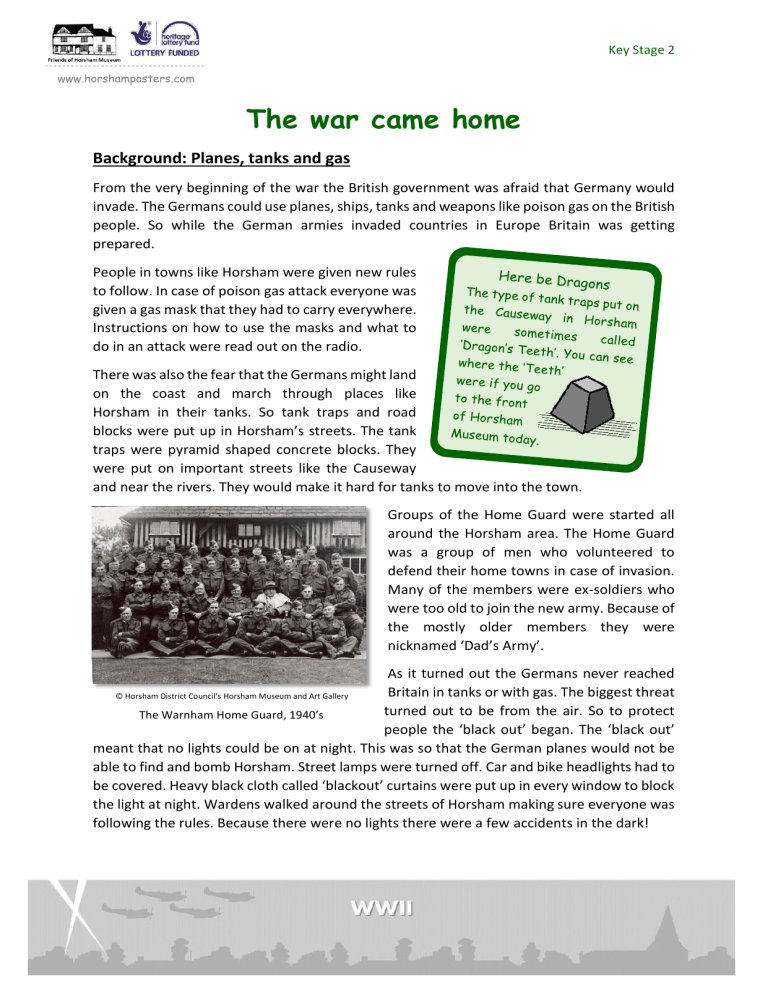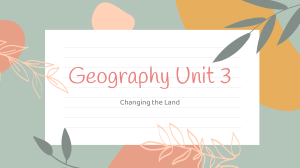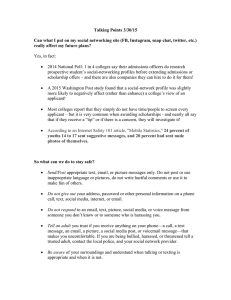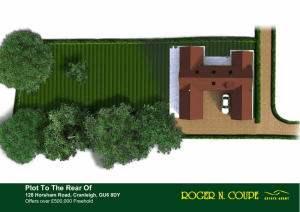
Key Stage 2 www.horshamposters.com The war came home Background: Planes, tanks and gas From the very beginning of the war the British government was afraid that Germany would invade. The Germans could use planes, ships, tanks and weapons like poison gas on the British people. So while the German armies invaded countries in Europe Britain was getting prepared. People in towns like Horsham were given new rules to follow. In case of poison gas attack everyone was given a gas mask that they had to carry everywhere. Instructions on how to use the masks and what to do in an attack were read out on the radio. There was also the fear that the Germans might land on the coast and march through places like Horsham in their tanks. So tank traps and road blocks were put up in Horsham’s streets. The tank traps were pyramid shaped concrete blocks. They were put on important streets like the Causeway and near the rivers. They would make it hard for tanks to move into the town. Groups of the Home Guard were started all around the Horsham area. The Home Guard was a group of men who volunteered to defend their home towns in case of invasion. Many of the members were ex-soldiers who were too old to join the new army. Because of the mostly older members they were nicknamed ‘Dad’s Army’. As it turned out the Germans never reached Britain in tanks or with gas. The biggest threat © Horsham District Council’s Horsham Museum and Art Gallery turned out to be from the air. So to protect The Warnham Home Guard, 1940’s people the ‘black out’ began. The ‘black out’ meant that no lights could be on at night. This was so that the German planes would not be able to find and bomb Horsham. Street lamps were turned off. Car and bike headlights had to be covered. Heavy black cloth called ‘blackout’ curtains were put up in every window to block the light at night. Wardens walked around the streets of Horsham making sure everyone was following the rules. Because there were no lights there were a few accidents in the dark! Key Stage 2 www.horshamposters.com Air raid shelters were built in town for the public. Most people also built their own shelter at home. They put up ‘Anderson shelters’ in their gardens. These were dug into the garden and made out of corrugated (wavy) iron. They were covered in soil so that they would be hidden. If you didn’t have a garden you could put up a ‘Morrison shelter’ instead. This shelter went inside one of the rooms of your house. Everyone would hide in these shelters when the air raid siren sounded. The siren was sounded whenever enemy planes were heading towards Horsham. The Royal Observer Corps (ROC) would keep a look out for planes from posts all around the town. The Horsham ROC headquarters at the Drill Hall would also get messages from other ROC posts on the coast. Not all the villages around Horsham had air raid sirens and had very little warning before an attack came. Despite these protections Horsham and the villages around it was bombed in the war. Horsham was not a major target like London. But it did have a main road and a railway. These were targets for the Germans. Horsham was still much safer for evacuees than the big cities like London which were badly damaged by bombs. The worst attacks on the area mostly happened during the Battle of Britain. One night in September 1940 there was a terrible attack on © West Sussex County Council Library Service and Colgate. The first bomb dropped on the District Record Office Nurses House. She survived and was taken to the Photo of the Orchard Road bomb site. West th Sussex County Times 6 December 1940. Village Hall First Aid Post. Sadly another two bombs fell soon after and landed on the Post Office and the Village Hall killing the Nurse and four other people. The worst attack in Horsham was in November 1940 on Orchard Road. Houses were destroyed and seven people including a young evacuee from London were sadly killed. After the houses were made safe or knocked down they were left empty. They were not rebuilt until after the war. Censorship The government was very worried about the enemy learning facts about Britain during the war in case they could help the Germans win. So there were very strict rules about what you could write down in Newspapers and what you could take photographs of. They would even read letters to and from soldiers in case they were stolen by enemy spies. This was called ‘Censorship’. Facts like places, dates and names were blacked out or removed. Key Stage 2 www.horshamposters.com Activity 1: Fighting back British Soldiers had to fight off aircraft, tanks and poison gas on the Front Line. The British Army had a range of equipment, vehicles and weapons to help them fight. Look at Sources 1and 2. Can you find the answers to the questions below? 1. What was one of Britain’s biggest guns? 2. Which gun would have been used against low-flying aircraft? 3. Name at least three things carried by soldiers to protect against poison gas Activity 2: Defending Horsham Horsham prepared to protect itself against enemy aircraft, tanks and poison gas. Look at Sources 4-6. Can you find answers to the questions below? 1. Which source(s) tell you about changes made to Horsham town to protect against attacks? Name one of the changes shown. Source: Change: 2. Which source(s) tell you about what to do in a poison gas attack? Source: 3. How would people know that poison gas was heading for Horsham? Key Stage 2 www.horshamposters.com Activity 3: Censor Below is a short part of a story that was not put in the paper during the war because of censorship. It was remembered by journalist, John Buchanan after the war. He told the story to Cliff White who put it in his book Horsham Town and Country: ‘When the Siren Sounded’. It is about Nellie Vesta Laughton, Horsham’s only woman Councillor who helped the police direct traffic during the war. However some of the words have been censored. Can you work out which censored words are missing? Write them back into the sentences. When you are finished you will be able to read the story. “A convoy of Canadian tanks was coming through the town. A dozen maybe. They came up West Street and somehow three got into Middle Street. The Canadians’ military police saw there was a problem with the narrowness of s’ own Middle Street and diverted the rest round the Carfax. This was Nellie’s big moment. The three tanks in Middle Street could have got through – just. But while they stopped to measure clearances the other tanks rounded the Carfax and the policemen were busy ushering them into East Street. Nellie went down Middle Street ordering the three tanks to back. She waved her arms and shouted, all black hat, scarf and handbag, a sort of oversize bat that would have frightened anyone, even a man in a big tank. The men in the first tank’s turret made the mistake of turning the gun was not all that big, but it went through a draper’s plate glass man in the turret reversed it and the turret round. The window . The gun went through a chemist’s shop window on the other side. After that all the tank turrets swung as the soldiers followed Nellie’s instructions. There seemed to be glass, curtains and underwear all over Middle Street and draped on the guns.” policemen gun tanks Middle turret Canadian bat underwear window Key Stage 2 www.horshamposters.com Source 1: National poster put up in Horsham. This was meant to encourage people to give money to the War Effort by buying War Savings. The pictures show the important items their money could be used to buy. Poster No.: 1998.1446 © Horsham District Council’s Horsham Museum and Art Gallery Key Stage 2 www.horshamposters.com Source 2: National poster put up in Horsham. This was meant to encourage people to give money to the War Effort by buying War Savings. The pictures show the important weapons their money could be used to buy. Poster No.: 1998.1449 © Horsham District Council’s Horsham Museum and Art Gallery Key Stage 2 www.horshamposters.com Source 6: Important Government Announcement read out on BBC radio. Quoted in Horsham Town and Country: ‘When the Siren Sounded’ by Cliff White, 1995. Gas and warfare “If poison gas has been used you will be warned by means of hand rattle. If you hear hand rattles do not leave your shelters until the poisoned gas has been cleared away. Hand bells will be used to tell you when there is no longer any danger from poisoned gas.” Source 5: Photograph of tank traps being removed from Horsham’s Streets after the war. Photograph was in the West Sussex County Times. © West Sussex County Council Library Service and Record Office Key Stage 2 www.horshamposters.com Source 6: Photograph of Public Air Raid shelters being removed from East Street after the war in 1948. © Horsham District Council’s Horsham Museum and Art Gallery


